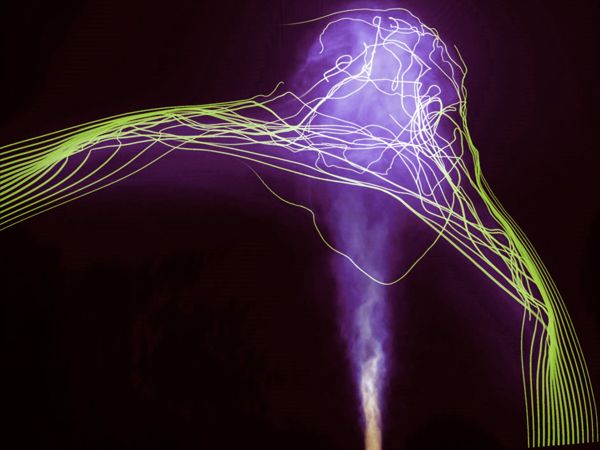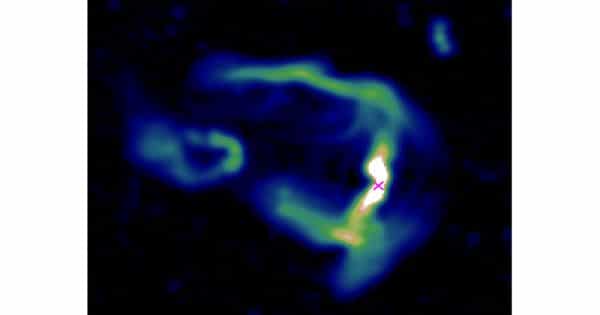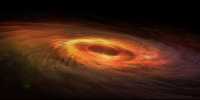The most massive and largest astronomical objects in the Universe are galaxies clusters. A cluster evolves as a result of collisions and accretion with surrounding matter. Such violent events produce a shock and wake (dubbed the “cold front”) in the highly ionized plasma, also known as the intra-cluster medium: ICM. By compressing and draping the intra-cluster magnetic fields, these structures can heat up the ICM, induce motion in plasma, and amplify the magnetic field. The conversion of gravitational energy to thermal and non-thermal energy is critical for understanding the evolution of galaxy clusters.
According to new observations and simulations, jets of high-energy particles emitted from the central massive black hole in the brightest galaxy in a galaxy cluster can be used to map the structure of invisible inter-cluster magnetic fields. These findings give astronomers a new tool for investigating previously unknown aspects of galaxy clusters.
New observations and simulations show that jets of high-energy particles emitted from the central massive black hole in the brightest galaxy in galaxy clusters can be used to map the structure of invisible inter-cluster magnetic fields. These findings provide astronomers with a new tool for investigating previously unexplored aspects of clusters of galaxies.
Bow shocks and wakes in dilute plasma are created as clusters of galaxies grow through collisions with surrounding matter. The plasma motion caused by these activities has the potential to drape intra-cluster magnetic layers, forming virtual magnetic force walls. However, these magnetic layers can only be seen indirectly when something interacts with them. Because such interactions are simply difficult to detect, the nature of intra-cluster magnetic fields remains unknown. A novel approach to mapping and characterizing magnetic layers is desperately needed.
An international team of astronomers including Haruka Sakemi, a graduate student at Kyushu University (now a research fellow at the National Astronomical Observatory of Japan – NAOJ), used the MeerKAT radio telescope located in the Northern Karoo desert of South Africa to observe a bright galaxy in the merging galaxy cluster Abell 3376 known as MRC 0600-399.

MRC 0600-399 is known to have unusual jet structures bent to 90-degree angles and is located more than 600 million light-years away in the direction of the constellation Columba. Previous X-ray observations revealed that MRC 0600-399 is the core of a sub-cluster that penetrates the main cluster of galaxies, indicating the presence of strong magnetic layers at the main and sub-cluster boundaries. Because of these characteristics, MRC 0600-399 is an ideal laboratory for studying interactions between jets and strong magnetic layers.
The MeerKAT observations revealed previously unseen jet details, most notably a faint “double-scythe” structure extending in the opposite direction from the bend points and forming a “T” shape. These new details show that this is a very chaotic collision, similar to a stream of water colliding with a pane of glass. To explain the observed jet morphology and possible magnetic field configurations, computer simulations are required.
Takumi Ohmura, a graduate student at Kyushu University (now a research fellow at the University of Tokyo’s Institute for Cosmic-Ray Research — ICRR), and other members of the team ran simulations on NAOJ’s supercomputer ATERUI II, the world’s most powerful computer dedicated to astronomical calculations. The simulations assumed an arch-like strong magnetic field while ignoring messy details like turbulence and galaxy motion.
This simple model matches the observations well, indicating that the magnetic pattern used in the simulation accurately reflects the magnetic field intensity and structure around MRC 0600-399. More importantly, it shows that the simulations can accurately represent the underlying physics, allowing them to be applied to other objects to characterize more complex magnetic field structures in galaxies clusters. This gives astronomers a new way to understand the magnetized Universe, as well as a tool for analyzing higher-quality data from future radio observatories such as the SKA (the Square Kilometre Array).














